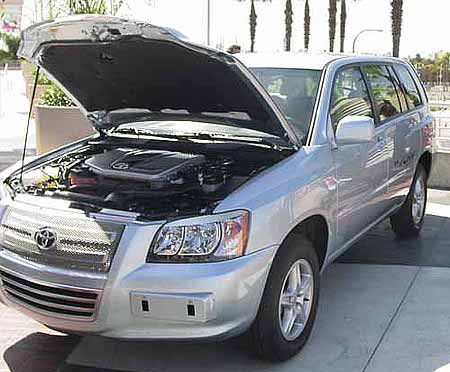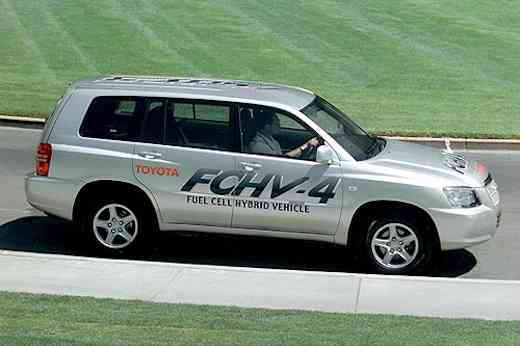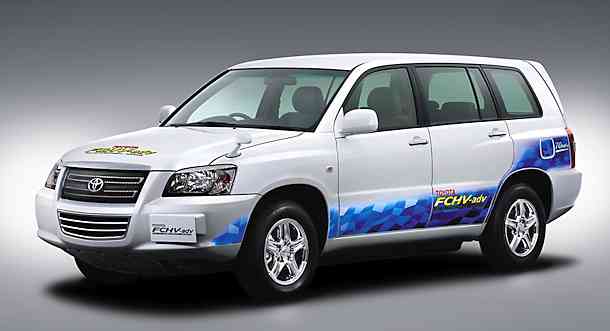Toyota FCHV Hydrogen Hybrid Vehicle
The Toyota FCHV Hydrogen Hybrid Vehicle is built upon the Highlander and based upon the Prius hybrid and new technology. The Toyota FCHV (fuel cell hybrid vehicle) is based upon years of hydrogen car development starting in 1992. The Toyota FCHV-6 (or just FCHV as they are calling it) is the newest of the FCHV SUV vehicles and differs from the FCHV-3, FCHV-4 and FCHV-5 in many important ways.
 Toyota FCHV Hydrogen Hybrid Vehicle – Photo Courtesy Kevin Kantola |
For instance, the Toyota FCHV-3 contained hydrogen-absorbing alloy tanks. The Toyota FCHV-4 was focused more on the hybrid capabilities and shared technology with the Prius such as regenerative braking to recharge the batteries and its Hybrid Synergy Drive system. The Toyota FCHV-4 also was the first to use a Toyota in-house built fuel cell stack. The FCHV-4 also boasted a new cooling system that used C02 as the coolant instead of hydrofluorocarbons (HFCs), making it an even more environmentally friendly vehicle.
The Toyota FCHV-5 generates hydrogen using a clean hydrogen fuel (CHF) reformer coupled with a newly developed catalyst and heat exchanger. According to Toyota, “CHF can be produced from crude oil, natural gas or coal and it has a low sulfur content. CHF is also used as a fuel for gasoline engine vehicles and can be supplied by current gasoline pumps. Therefore, FCHV-5 will be useful where hydrogen supply infrastructure is not available.”

The Toyota FCHV has gone away from the CHF reformer and uses a polymer electrolyte PEM fuel cell stack generating 90 kw of electricity to its two permanent magnet electric motors rated at 80 kw (109 hp). The FCHV uses four compressed hydrogen tanks at 5,000 psi, has a top speed of 96 mph and a cruising range of 180 miles. Of course that was the earlier version. The Toyota FCHV introduced in Fall 2007, uses 10,000 psi tanks and has range of over 500 miles. The Toyota FCHV also uses a nickel-metal hydride battery (21 kw) to supply electricity to the motors, supplementing the fuel cell output during acceleration.
The brains of the fuel cell hybrid system is the power control unit, which sits directly under the hood of the vehicle. This system regulates fuel cell output and battery charging and discharging as needed according to driving conditions.
Even though the Toyota FCHV was built upon the Highlander platform, the FCHV is lighter due to the use of aluminum fenders, roof and other components and has a large rear spoiler for less wind resistance. The tail lights also use low-power consuming LED’s.
The Toyota FCHV is Japan’s first fuel cell vehicle to acquire vehicle type certification under the Road Vehicles Act by Japan’s Ministry of Land, Infrastructure and Transport (MLIT).

The new model is the Toyota FCHV-adv which stands for “Advanced”. The advanced part of the Toyota FCHV-adv means the fuel cell and hybrid battery systems have been revamped for more power and endurance. The FCHV-adv also has a longer range than previous versions averaging in the 400 plus to 500 plus mile range.
Written by Hydro Kevin Kantola